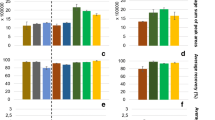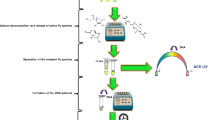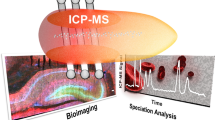Abstract
Flow-through electrochemical conversion (EC) of drug-like molecules was hyphenated to miniaturized nuclear magnetic resonance spectroscopy (NMR) via on-line solid-phase extraction (SPE). After EC of the prominent p38α mitogen-activated protein kinase inhibitor BIRB796 into its reactive products, the SPE step provided preconcentration of the EC products and solvent exchange for NMR analysis. The acquisition of NMR spectra of the mass-limited samples was achieved in a stripline probe with a detection volume of 150 nL offering superior mass sensitivity. This hyphenated EC–SPE–stripline-NMR setup enabled the detection of the reactive products using only minute amounts of substrate. Furthermore, the integration of conversion and detection into one flow setup counteracts incorrect assessments caused by the degradation of reactive products. However, apparent interferences of the NMR magnetic field with the EC, leading to a low product yield, so far demanded relatively long signal averaging. A critical assessment of what is and what is not (yet) possible with this approach is presented, for example in terms of structure elucidation and the estimation of concentrations. Additionally, promising routes for further improvement of EC–SPE–stripline-NMR are discussed.






Similar content being viewed by others
References
Jahn S, Karst U (2012) Electrochemistry coupled to (liquid chromatography/) mass spectrometry—current state and future perspectives. J Chromatogr A 1259:16–49
Richards JA, Evans DH (1975) Flow cell for electrolysis within probe of a nuclear magnetic-resonance spectrometer. Anal Chem 47(6):964–966
Albert K, Dreher EL, Straub H, Rieker A (1987) Monitoring electrochemical reactions by C-13 NMR spectroscopy. Magn Reson Chem 25(10):919–922
Zhang XC, Zwanziger JW (2011) Design and applications of an in situ electrochemical NMR cell. J Magn Reson 208(1):136–147
Wu JJ, Day JB, Franaszczuk K, Montez B, Oldfield E, Wieckowski A, Vuissoz PA, Ansermet JP (1997) Recent progress in surface NMR-electrochemistry. J Chem Soc Faraday Trans 93(6):1017–1026
Mairanovsky VG, Yusefovich LY, Filippova TM (1983) NMR electrolysis combined method (NMREL)—basic principles and some applications. J Magn Reson 54(1):19–35
Simon H, Melles D, Jacquoilleot S, Sanderson P, Zazzeroni R, Karst U (2012) Combination of electrochemistry and nuclear magnetic resonance spectroscopy for metabolism studies. Anal Chem 84(20):8777–8782
Gokay O, Albert K (2012) From single to multiple microcoil flow probe NMR and related capillary techniques: a review. Anal Bioanal Chem 402(2):647–669
Corcoran O, Spraul M (2003) LC-NMR-MS in drug discovery. Drug Discov Today 8(14):624–631
Baumann A, Karst U (2010) Online electrochemistry/mass spectrometry in drug metabolism studies: principles and applications. Expert Opin Drug Metab Toxicol 6(6):715–731
Falck D, de Vlieger JSB, Giera M, Honing M, Irth H, Niessen WMA, Kool J (2012) On-line electrochemistry-bioaffinity screening with parallel HR-LC-MS for the generation and characterization of modified p38alpha kinase inhibitors. Anal Bioanal Chem 403(2):367–375
van Bentum PJM, Janssen JWG, Kentgens APM, Bart J, Gardeniers JGE (2007) Stripline probes for nuclear magnetic resonance. J Magn Reson 189(1):104–113
Bart J, Janssen JWG, van Bentum PJM, Kentgens APM, Gardeniers JGE (2009) Optimization of stripline-based microfluidic chips for high-resolution NMR. J Magn Reson 201(2):175–185
Bart J, Kolkman AJ, Oosthoek-de Vries AJ, Koch K, Nieuwland PJ, Janssen JWG, van Bentum JPM, Ampt KAM, Rutjes FPTJ, Wijmenga SS, Gardeniers JGE, Kentgens APM (2009) A microfluidic high-resolution NMR flow probe. J Am Chem Soc 131(14):5014–5015
Eglen RM, Reisine T (2009) The current status of drug discovery against the human kinome. Assay Drug Dev Technol 7(1):22–43
Kumar S, Boehm J, Lee JC (2003) p38 MAP kinases: key signalling molecules as therapeutic targets for inflammatory diseases. Nat Rev Drug Discov 2(9):717–726
Bax A, Davis DG (1985) MLEV-17-based two-dimensional homonuclear magnetization transfer spectroscopy. J Magn Reson 65:355–360
Aue WP, Karhan J, Ernst RR (1976) Homonuclear broad band decoupling and two-dimensional J-resolved NMR spectroscopy. J Chem Phys 64(10):4226
van Beek JD (2007) matNMR: a flexible toolbox for processing, analyzing and visualizing magnetic resonance data in Matlab. J Magn Reson 187(1):19–26
Eilers PH (2003) A perfect smoother. Anal Chem 75(14):3631–3636
http://www.bruker.com/products/mr/nmr/probes/cryoprobes/microcryoprobe/overview.html. Bruker. Accessed 11.03.2013 2013
Malz F, Jancke H (2005) Validation of quantitative NMR. J Pharm Biomed Anal 38(5):813–823
Kentgens APM, Bart J, van Bentum PJM, Brinkmann A, van Eck ERH, Gardeniers JGE, Janssen JWG, Knijn P, Vasa S, Verkuijlen MHW (2008) High-resolution liquid- and solid-state nuclear magnetic resonance of nanoliter sample volumes using microcoil detectors. J Chem Phys 128(5):052202
Jansma A, Chuan T, Albrecht RW, Olson DL, Peck TL, Geierstanger BH (2005) Automated microflow NMR: routine analysis of five-microliter samples. Anal Chem 77(19):6509–6515
Acknowledgments
This work was performed partly within the framework of the Dutch Top Institute Pharma project D2-102 (Metabolic stability assessment as new tool in the Hit-to-Lead selection process and the generation of new lead compound libraries) and partly within the research program ACTS—Process on a Chip (PoaC), financed by the Netherlands Organisation for Scientific Research (NWO). Agnieszka Kraj, Hendrik-Jan Brouwer and Jean-Pierre Chervet (Antec, Zoeterwoude, The Netherlands) are acknowledged for their support of the electrochemistry part of the project. Hans Janssen, Jan van Os, and Jan van Bentum (Radboud University Nijmegen, The Netherlands) are credited for technical and organizational support with regard to setup and ongoing development of the stripline probe. Additionally, Roald Tiggelaar, Jacob Bart and Han Gardeniers (Twente University/Mesoscale Chemical Systems, Enschede, The Netherlands) are acknowledged for their support of the stripline-NMR chip fabrication. Frans J.J. de Kanter and Andreas W. Ehlers are thanked for their input concerning the conventional NMR measurements.
Author information
Authors and Affiliations
Corresponding author
Electronic supplementary material
Below is the link to the electronic supplementary material.
ESM 1
(PDF 1.32 mb)
Rights and permissions
About this article
Cite this article
Falck, D., Oosthoek-de Vries, A.J., Kolkman, A. et al. EC–SPE–stripline-NMR analysis of reactive products: a feasibility study. Anal Bioanal Chem 405, 6711–6720 (2013). https://doi.org/10.1007/s00216-013-7158-9
Received:
Revised:
Accepted:
Published:
Issue Date:
DOI: https://doi.org/10.1007/s00216-013-7158-9




